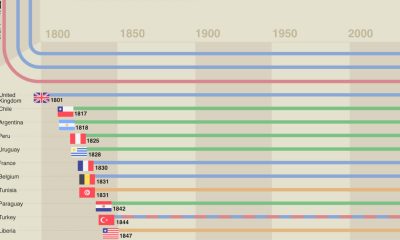Charts
New Map Shows Where Kids Eat the Most Sugar per Week
It is no secret that sugar does more harm than good – especially for children! Studies show a negative impact on learning, memory, and academic performance. It is also linked to obesity, fatty liver disease, diabetes, heart disease, asthma, and gout. Of course, cutting down is far easier said than done, especially when 70% of packaged foods and 80% of kids’ foods have added sugar! Of course, a sweet treat now and then most likely won’t have a long-term harmful impact, but it can be hard to place boundaries on sugar, especially with children. The American Heart Association reports that American children consume an average of 81 grams of added sugar per day – that is 65 pounds of added sugar per year! Where do children in the U.S. eat the most sugar? The team at MainStreetSmiles.com conducted an intriguing survey of parents on how many sugary snacks their children consume per week and day.
Click below to zoom
Do any of the results surprise you? I was honestly quite shocked by Pennsylvania, where parents reported an average of 3.266 sugary snacks consumed per day! I did a little digging on why this might be and found a few possible explanations. Pennsylvania is known as the “snack capital of the world”, the Pretzel Belt, and the Snack Belt – it is home to Hershey’s, Utz, Snyder, Just Born (Peeps, Mike & Ike’s), Breyer’s, and other major snack companies. Overall, it has a thriving snack food scene! While snacks are wonderful, moderation is key. Check out the Cincinnati Children’s Hospital’s tips on how to reduce sugar in your child’s diet. Overall, I love the color scheme and adorable header – I just want to take a bite out of those letters! The proportionate donuts are such a clever way to visualize the rankings. Fun and functional!
Charts
Explore the Best States for Car Enthusiasts
Do you have a passion for fast cars, scenic drives, and classic automobiles? If so, you might be curious about which states cater best to car lovers. The experts at Speedway Motors have developed a ranking system that evaluates each state based on the factors most important to auto enthusiasts. Their in-depth analysis reveals which parts of the country offer the best experience for those who live and breathe cars.
Click below to zoom.
How the Rankings Were Determined
Determining the ultimate destination for car fans isn’t an exact science, but the research team considered a variety of key factors to ensure a well-rounded assessment. Here’s what they looked at:
- The percentage of roads in excellent condition
- The average number of snow days per year
- The frequency of hailstorms annually
- Registration costs and duration
- The price of fuel per gallon
- The percentage of uninsured drivers
- The number of car shows held in the state
- The availability of auto racing venues
Do these factors align with what you’d consider important for an ideal car-friendly state? We think this method covers all the essential aspects—driving conditions, costs, events, and opportunities to enjoy the thrill of the road.
Top States for Car Lovers
Based on this ranking system, the following states earned top spots for their well-maintained roads, favorable weather, affordable fuel, and exciting car culture:
- Florida
- Alabama
- Idaho
- North Carolina
- West Virginia
- Tennessee
- Arizona
- Indiana
- New Hampshire
- Kentucky
Florida takes the lead as the best state for car enthusiasts, thanks to its warm climate, minimal snowfall, and well-kept roads. Car lovers will also appreciate the numerous auto events, such as the prestigious Amelia Island Concours d’Elegance, where rare and luxury cars take center stage. Racing fans, on the other hand, can enjoy the adrenaline rush of the iconic Daytona 500. Even though fuel prices are slightly above average, Florida’s thriving car culture more than makes up for it.
The State with the Most Car Meet-Ups
This chart’s strength comes from the way it breaks down specific aspects that appeal to car lovers. For example, if you don’t care about driving as much as you care about attending car shows, you can re-evaluate the rankings and bring the states with the highest scores for car shows to the top of your list. This would make California the top state in terms of car shows, with more than any other state. Monterey Car Week alone can satisfy even the most passionate enthusiasts!
The State with the Best Roads
For those who express their love of cars with road trips, you’ll be interested to know that Alabama has the best-kept roads in the nation. 75% of them are well-maintained and in good condition. They’re closely followed by New Hampshire at 74%.
States with Low Gas Prices
It’s hard to enjoy a good road trip if you blow your budget on gas. Oklahoma offers the most value for your money, with average gas prices of $2.53 per gallon at the time of the study. Texas came in second place at $.259 per gallon.
Charts
Study Highlights Disparity Between Homelessness Rates and Empty Housing
Homelessness in the United States remains a pressing issue, especially as rates have surged by 18.1% in 2024—a historic high. Vulnerable populations face rising housing costs, mass migration, and evictions, with many renters categorized as “cost-burdened.” Meanwhile, over 14 million vacant homes exist across the country, a number that far exceeds what’s needed to house every homeless individual.
A study by the Mortgage Calculator team maps this disparity, highlighting states with the highest ratio of vacant homes to homeless individuals. Mississippi tops the list with 187.31 vacant homes per homeless person. Despite high poverty levels, the state’s low cost of living and relatively small homeless population contribute to this striking ratio. Southern states dominate the map’s highest ratios, reflecting the availability of vacant housing in rural areas. However, these areas often lack the economic infrastructure and job opportunities necessary to support new residents, complicating potential solutions.
Click below to zoom
The findings reveal stark contrasts: urban areas, where jobs are more plentiful, tend to have higher homelessness rates but fewer vacant homes, while rural states have the opposite challenge. Advocates suggest that leveraging vacant housing could significantly reduce homelessness, but practical barriers remain. Addressing this issue will require not only repurposing unused housing but also creating sustainable economic opportunities to support vulnerable populations.
This study underscores the urgent need for innovative policies and programs to bridge the gap between empty housing and homelessness, offering hope for a more equitable future.
Charts
New Study Gives a Close Look at Global Waste and Recycling
A study by Paper Boss sheds light on the countries generating the most garbage per person, revealing critical insights into global waste production and recycling efforts. The top 10 waste-producing nations are Bahrain, Comoros, Canada, Denmark, the U.S., Kuwait, Switzerland, Trinidad and Tobago, Moldova, and Luxembourg.
Click below to zoom.
Bahrain, despite its small size, leads the list with 907 kilograms of waste per person annually. Rapid population growth and high levels of construction and industrial activity contribute significantly to this figure. Canada, ranking third with 777 kilograms of waste per person, offsets some of its impact by recycling 27% of its trash.
Germany stands out as the global leader in recycling, with an impressive 47% recycling rate. This success stems from a well-established culture of sustainability, where children are taught to separate waste from an early age. Strict regulations, including fines for failing to recycle, further reinforce this commitment.
Interestingly, nations like Switzerland, Denmark, and Luxembourg appear on both the highest waste-producing and top-recycling lists, reflecting a complex balance between consumption and sustainability efforts.
The study underscores the pressing need to address rising waste levels worldwide. Countries like Germany demonstrate how prioritizing education, infrastructure, and accountability can lead to more sustainable practices. By adopting such strategies, other nations could work toward effectively reducing their environmental footprint and combating the global waste crisis.
-

 Business Visualizations7 months ago
Business Visualizations7 months agoEverything Owned by Apple
-

 Business Visualizations6 months ago
Business Visualizations6 months agoAmerica’s Most Valuable Companies Ranked by Profit per Employee
-

 Maps2 years ago
Maps2 years agoThe Most Popular Surnames in Countries Around the World
-

 Business Visualizations2 months ago
Business Visualizations2 months agoThe Biggest Fortune 500 Company in Every State
-

 Misc Visuals2 years ago
Misc Visuals2 years agoHow to Pick a Perfect Watermelon
-

 Charts2 years ago
Charts2 years agoThe Most Popular Sport in Every Country Around the World
-

 Misc Visuals2 years ago
Misc Visuals2 years agoThe Ultimate Visual Guide to Boy Scout Patches and What They Mean
-

 Timelines1 year ago
Timelines1 year agoA History of the Oldest Flags in the World




